| | Purpose of survey | Methodology | Survey results | Acknowledgements
Purpose of Survey
To address some of the data and information needs of the Specialty Crop industry in Alberta, the Statistics and Data Development (SADD) Branch has been conducting an annual Specialty Crop Survey. Now into its nineteenth year, the survey attempts to capture data on area (seeded and harvested acres), yield and production, for the various types of specialty crops grown. Data gathered from the survey are used primarily to generate related provincial and sub-provincial estimates by the SADD Branch. In turn, these estimates are used to validate some of the Alberta estimates generated by Statistics Canada, as well as to provide industry and other stakeholders with benchmark statistics for some of the "new" and emerging crops grown in the province.
Methodology
The Specialty Crop Survey, which is provincial in scope, collects data through a non-probability sampling procedure. In December 2001, survey questionnaires were mailed out to 4,583 specialty crop producers across Alberta. The questionnaires specifically asked survey participants to provide, at their earliest convenience, information on the type of specialty crop grown, area (seeded and harvested acres), yield and production for the year 2001. Survey participants were also made aware that participation in the survey was voluntary. Moreover, all individual responses would be kept confidential under the provisions of the Federal Statistics Act, as well as under the Provincial Freedom of Information and Protection of Privacy (FOIP) Act, by which the SADD Unit is governed and operates. As of February 25, 2002, a total of 1,269 questionnaires were returned. Of this total, 1,121 were usable and formed part of the basis in the generation of the Alberta 2001 specialty crop estimates.
Survey responses received were reviewed for data completeness, validated and entered into an electronic database. The data was then subjected to some computerized analyses, the results of which were rolled up into group summaries, to preserve data confidentiality of individual survey respondents. In turn, the group summaries, in conjunction with consultations with industry, published sources (e.g. Statistics Canada) and Alberta Agriculture, Food and Rural Development (AAFRD) subject area/provincial specialists were used to generate the provincial and sub-provincial (Census Division) estimates, where appropriate. It cannot be over emphasized that extensive consultation is done with AAFRD's subject area/provincial specialists and industry, in the derivation of the provincial/sub-provincial estimates, especially in instances where specialty crop production tended to be localized/regionalized. For example, mustard and lentils are grown mainly in the Southern Region and eastern areas of the Central Region. Largely due to proximity and familiarity with local conditions, provincial specialists in district/regional offices tend to offer useful information and valuable insights on crop conditions and yields, particularly when attempting to firm up some of the sub-provincial estimates generated from the survey. Likewise, administrative data showing yield and crop area grown under private contracts also tend to add value to some of the estimates.
It should be noted that the derived estimates are subject to error. Some of the possible causes of error include data coding, entry editing and tabulation. Nonetheless, we believe that the statistics published in this report are reliable estimates for Alberta.
Survey Results
Area, yield and production in Alberta
Relatively low prices for major grains/oilseeds and high farm input costs in the spring of 2001, in addition to need for diversification and crop rotation, had many Alberta producers seeding specialty crops in 2001.
Slightly over one million acres were seeded to specialty crops in Alberta in 2001, as seen in Figure 1, of which, 954,800 acres were harvested (excluding potatoes and forage seeds). About 118,500 acres were not harvested due to drought conditions, insect problems and other adverse factors experienced during the 2001 crop season. These adverse factors generally reduced yields and area harvested for specialty crops grown on dry land. As a result, 2001 production for most specialty crops was lower than in 2000.
Record or near record low yields were reported for mustard, lentils and chickpeas in 2001. These crops are primarily grown on dry land in the southeastern parts of Alberta, where drought conditions and insect problems prevailed through most of the 2001 crop season. However, specialty crops under irrigation, including potatoes, sugar beets, dry beans and forage corn, had near average to above average yields, though supply of irrigation water was a major concern in 2001.
Specialty crop seeding intentions for 2002 are not available (from the survey) due to a lack of data to generate appropriate estimates. Statistics Canada's March Intentions of Principal Field Crop Areas 2002 will be released on April 24, 2002, which will cover major crops and some specialty crops.
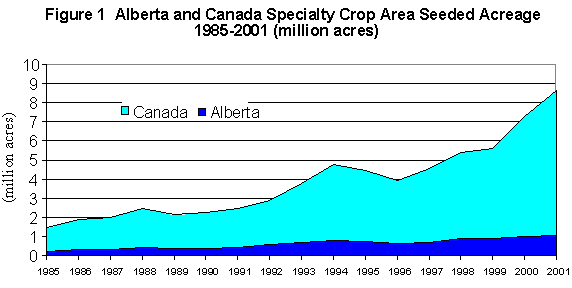
Specialty crops in western Canada
In 2001, specialty crop area in Western Canada continued to increase, thanks to a much higher acreage in Saskatchewan. About 8.25 million acres were seeded to specialty crops in Western Canada in 2001, of which, 7.80 million acres were harvested, according to Statistics Canada's November Production Estimate of 2001 Field Crops and the Alberta 2001 Specialty Crop Survey. Adverse weather conditions experienced during the 2001 season reduced yields and area harvested for specialty crops in Western Canada.
In 2001, dry peas remained the largest specialty crop in Western Canada, with harvested area estimated at 3.45 million acres and production at 2.20 million tonnes. Only 0.58 million tonnes of lentils were produced from 1.71 million acres harvested due to yields that were significantly below average. Harvested area for chickpeas was estimated at 1.18 million acres and production at 0.47 million tonnes. Mustard production in 2001 was 94,300 tonnes from 359,000 acres harvested. Also, about 91,500 tonnes of canary seed were produced from 0.34 million acres harvested in 2001.
Saskatchewan remained the largest producer of specialty crops in 2001. Saskatchewan harvested 6.08 million acres of specialty crops in 2001, compared to 5.42 million acres in 2000. Total harvested area in Saskatchewan was estimated at 2.65 million acres for dry peas, 1.69 million acres for lentils, 1.10 million acres for chickpeas, 285,000 acres for mustard seed, 285,000 acres for canary seed and 20,000 acres for sunflower seed in 2001.
In 2001, a total of 735,000 acres of specialty crops were harvested in Manitoba. Sunflower harvested area in Manitoba was estimated at 130,000 acres in 2001, accounting for 83% of total sunflower area in Western Canada. In addition, Manitoba harvested 190,000 acres of dry beans, 175,000 acres of dry peas, 70,000 acres of grain corn, 55,000 acres of canary seed, 25,000 acres of buckwheat and 4,000 acres of lentils in 2001.
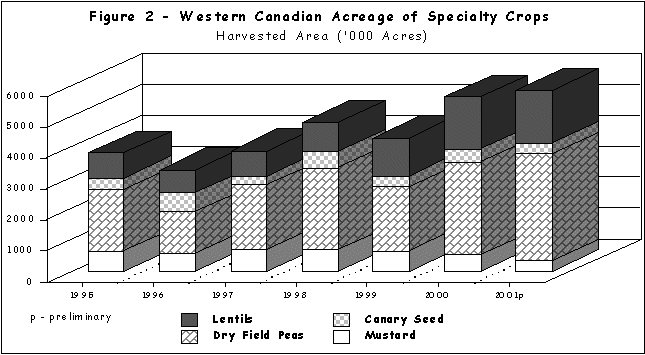
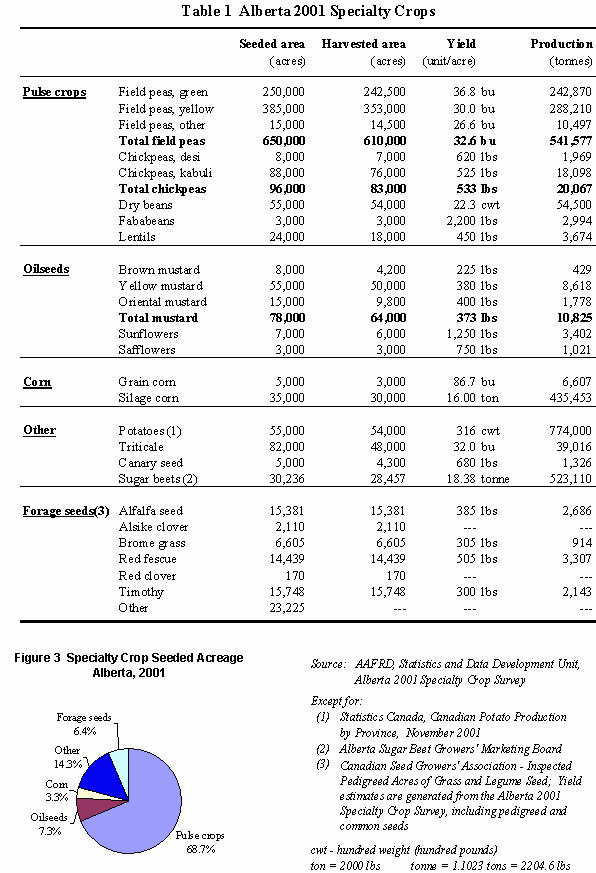
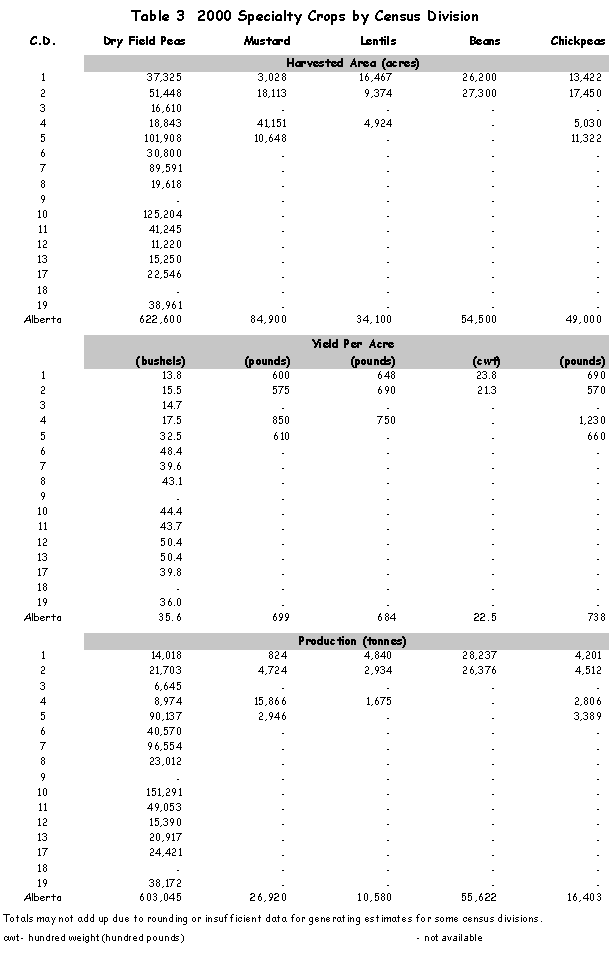
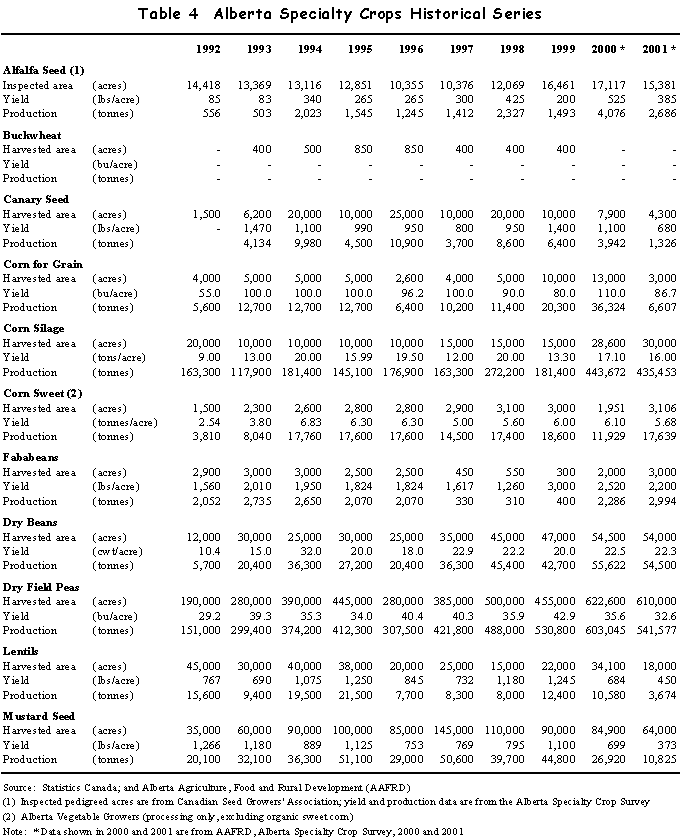
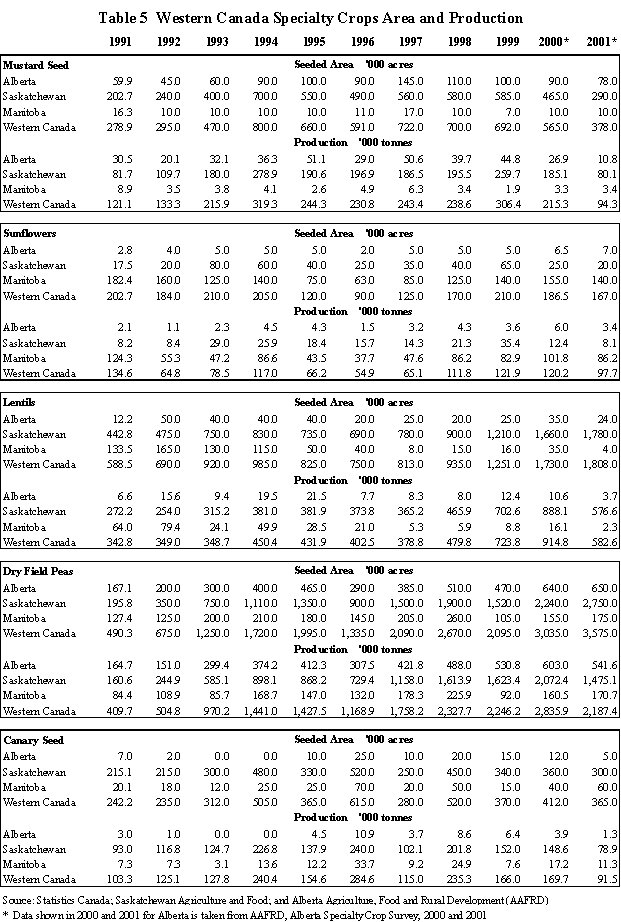
Acknowledgments
We gratefully acknowledge the participation of producers of specialty crops across the province. Without their cooperation, this report would not have been possible. In addition, the contributions of Alberta Agriculture, Food and Rural Development staff, including Chuanliang Su, Reynold Jaipaul, Shukun Guan, Guangzhi Liu, Melodie Mynzak, Gail Atkinson, Marion Harry, Brenda Kerychuk, Charlie Pearson, Nabi Chaudhary, Michael Clawson, Dr. Stan Blade, Neil Clark, L. Maskewich, Ken Lopetinsky, Manjula Bandara, Collin Wildschut, Carina Weisbach, Liz Russell, Judy Webber, Travis Simo, Rachid El Hafid, Lynda Ost and J. Thibodeau, is very much appreciated.
For additional information relating to the various sections of this report, please do not hesitate to contact the subject area specialist referenced under each section.
Maureen Wenger, Survey Operations Manager
Survey Services Team
Statistics and Data Development Branch
Alberta Agriculture, Food & Rural Development
Phone: (780) 422-2903
Email: maureen.wenger@gov.ab.ca |
|